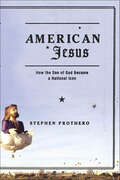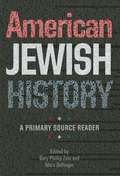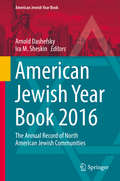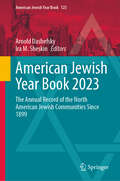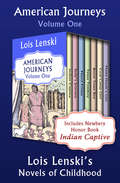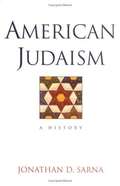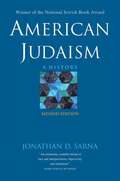- Table View
- List View
American Jesuits and the World: How an Embattled Religious Order Made Modern Catholicism Global
by John T. McgreevyAt the start of the nineteenth century, the Jesuits seemed fated for oblivion. Dissolved as a religious order in 1773 by one pope, they were restored in 1814 by another, but with only six hundred aged members. Yet a century later, the Jesuits numbered seventeen thousand men and were at the vanguard of the Catholic Church's expansion around the world. In the United States especially, foreign-born Jesuits built universities and schools, aided Catholic immigrants, and served as missionaries. This book traces this nineteenth-century resurgence, showing how Jesuits nurtured a Catholic modernity through a disciplined counterculture of parishes, schools, and associations.Drawing on archival materials from three continents, American Jesuits and the World tracks Jesuits who left Europe for America and Jesuits who left the United States for missionary ventures across the Pacific. Each chapter tells the story of a revealing or controversial event, including the tarring and feathering of an exiled Swiss Jesuit in Maine, the efforts of French Jesuits in Louisiana to obtain Vatican approval of a miraculous healing, and the educational efforts of American Jesuits in Manila. These stories place the Jesuits at the center of the worldwide clash between Catholics and liberal nationalists, and reveal how the Jesuits not only revived their own order but made modern Catholicism more global.The result is a major contribution to modern global history and an invaluable examination of the meaning of religious liberty in a pluralistic age.
American Jesus: How the Son of God Became a National Icon
by Stephen ProtheroThe many guises in which Jesus has been represented.
American Jesus: How the Son of God Became a National Icon
by Stephen ProtheroA Deep Dive into America's Complex Relationship with JesusThere's no denying America's rich religious background–belief is woven into daily life. But as Stephen Prothero argues in American Jesus, many of the most interesting appraisals of Jesus have emerged outside the churches: in music, film, and popular culture; and among Jews, Muslims, Buddhists, and people of no religion at all.Delve into this compelling chronicle as it explores how Jesus, the carpenter from Nazareth, has been refashioned into distinctly American identities over the centuries. From his enlistment as a beacon of hope for abolitionists to his appropriation as a figurehead for Klansmen, the image of Jesus has been as mercurial as it is influential. In this diverse and conflicted scene, American Jesus stands as a testament to the peculiar fusion of the temporal and divine in contemporary America.Equal parts enlightening and entertaining, American Jesus goes beyond being simply a work of history. It’s an intricate mirror, reflecting the American spirit while questioning the nation's socio-cultural fabric.
American Jewish Filmmakers
by Lester D. Friedman David DesserWoody Allen, Mel Brooks, Sidney Lumet, and Paul Mazursky, all sons of East European Jews, remain among the most prominent contemporary American film directors. In this revised, updated second edition of American Jewish Filmmakers, David Desser and Lester D. Friedman demonstrate how the Jewish experience gives rise to an intimately linked series of issues in the films of these and other significant Jewish directors. The effects of the Holocaust linger, both in gripping dramatic form (Mazursky's Enemies, a Love Story) and in black comedy (Brooks's The Producers). In his trilogy consisting of Serpico, Prince of the City, and Q&A, Lumet focuses on the failure of society's institutions to deliver social justice. Woody Allen portrays urban life and family relationships (Manhattan and Hannah and Her Sisters), sometimes with a nostalgic twist (Radio Days). This edition concludes with a newly written discussion of the careers of other prominent Jewish filmmakers such as Steven Spielberg, Barry Levinson, Brian Singer, and Darren Aronofsky.
American Jewish History: A Primary Source Reader
by Marc Dollinger Gary ZolaPresenting the American Jewish historical experience from its communal beginnings to the present through documents, photographs, and other illustrations, many of which have never before been published, this entirely new collection of source materials complements existing textbooks on American Jewish history with an organization and pedagogy that reflect the latest historiographical trends and the most creative teaching approaches. Ten chapters, organized chronologically, include source materials that highlight the major thematic questions of each era and tell many stories about what it was like to immigrate and acculturate to American life, practice different forms of Judaism, engage with the larger political, economic, and social cultures that surrounded American Jews, and offer assistance to Jews in need around the world. At the beginning of each chapter, the editors provide a brief historical overview highlighting some of the most important developments in both American and American Jewish history during that particular era. Source materials in the collection are preceded by short headnotes that orient readers to the documentsÕ historical context and significance.
American Jewish Identity Politics
by Deborah Dash MooreWritten by scholars who grew up after World War II and the Holocaust who participated in political struggles in the 1960s and 1970s and who articulated many of the formative concepts of modern Jewish studies, this anthology provides a window into an era of social change. These men and women are among the leading scholars of Jewish history, society and culture. The volume is organized around contested themes in American Jewish life: the Holocaust and World War II, religious pluralism and authenticity, intermarriage and Jewish continuity. Thus, it offers one of the few opportunities for students to learn about these debates from participant scholars.
American Jewish Landmarks: A Travel Guide and History, Volume I
by Bernard Postal Lionel Koppman"American Jewish Landmarks" contains valuable historical data on all 50 states, Washington, D.C., Puerto Rico, and the Virgin Islands; and is required reading for people interested in the Jewish landmarks of the United States and her territorial possessions. It is also worth bearing in mind that this book is more than a manual for the tourist, it is an important book for students of American Jewish history.
American Jewish Year Book 2015: The Annual Record of the North American Jewish Communities (American Jewish Year Book #115)
by Arnold Dashefsky Ira M. SheskinThis Year Book, now in its 115th year, provides insight into major trends in the North American Jewish communities and is the Annual Record of the North American Jewish Communities. The first two chapters of Part I examine Jewish immigrant groups to the US and Jewish life on campus. Chapters on "National Affairs" and "Jewish Communal Affairs" analyze the year's events. Three chapters analyze the demography and geography of the US, Canada, and world Jewish populations. Part II provides Jewish Federations, Jewish Community Centers, social service agencies, national organizations, overnight camps, museums, and Israeli consulates. The final chapters present national and local Jewish periodicals and broadcast media; academic resources, including Jewish Studies Programs, books, articles websites, and research libraries; and lists of major events in the past year, Jewish honorees, and obituaries. For those interested in the North American Jewish community--scholars, service providers, volunteers--this volume undoubtedly provides the single best source of information on the structure, dynamics, and ongoing religious, political, and social challenges confronting the community. It should be on the bookshelf of everyone interested in monitoring the dynamics of change in the Jewish communities of North America. Sidney Goldstein, Founder and Director, Population Studies and Training Center, Brown University, and Alice Goldstein, Population Studies and Traini ng Center, Brown University The American Jewish Year Book is a unique and valuable resource for Jewish community professionals. It is part almanac, directory, encyclopedia and all together a volume to have within easy reach. It is the best, concise diary of trends, events, and personalities of interest for the past year. We should all welcome the Year Book's publication as a sign of vitality for the Jewish community. Brenda Gevertz, Executive Director, JPRO Network, the Jewish Professional Resource Organization
American Jewish Year Book 2016: The Annual Record of North American Jewish Communities (American Jewish Year Book #116)
by Arnold Dashefsky Ira M. SheskinThe American Jewish Year Book, now in its 116th year, is the annual record of the North American Jewish communities and provides insight into their major trends. Part I presents a forum on the Pew Survey, "A Portrait of American Orthodox Jews. " Part II begins with Chapter 13, "The Jewish Family. " Chapter 14 examines "American Jews and the International Arena (April 1, 2015 - April 15, 2016), which focuses on US-Israel Relations. Chapters 15-17 analyze the demography and geography of the US, Canadian, and world Jewish populations. In Part III, Chapter 18 provides lists of Jewish institutions, including federations, community centers, social service agencies, national organizations, synagogues, Hillels, day schools, camps, museums, and Israeli consulates. In the final chapters, Chapter 19 presents national and local Jewish periodicals and broadcast media; Chapter 20 provides academic resources, including Jewish Studies programs, books, articles, websites, and research libraries; and Chapter 21 presents lists of major events in the past year, Jewish honorees, and obituaries. An invaluable record of Jewish life, the American Jewish Year Book illuminates contemporary issues with insight and breadth. It is a window into a complex and ever-changing world. Deborah Dash Moore, Frederick G. L. Huetwell Professor of History and Judaic Studies, and Director Emerita of the Frankel Center for Judaic Studies, University of Michigan A century from now and more, the stately volumes of the American Jewish Year Book will stand as the authoritative record of Jewish life since 1900. For anyone interested in tracing the long-term evolution of Jewish social, political, religious, and cultural trends from an objective yet passionately Jewish perspective, there simply is no substitute. Lawrence Grossman, American Jewish Year Book Editor (1999-2008) and Contributor (1988-2015)
American Jewish Year Book 2023: The Annual Record of the North American Jewish Communities Since 1899 (American Jewish Year Book #123)
by Arnold Dashefsky Ira M. SheskinAcross three centuries, AJYB has provided insight into major trends. Part I of the current volume contains eight chapters: The first lead chapter includes an Audit of Antisemitic Incidents in 2023 produced by the ADL, and the second chapter examines Denominational Identity and Jewish Engagement. Subsequent chapters analyze recent domestic and international events as they affect the American Jewish community, major events in the past year, and the demography and geography of the US, Canada, and World Jewish populations. Part II contains nine chapters: lists of local Jewish organizations; Jewish museums, and Holocaust museums and monuments; overnight camps; national Jewish organizations; Jewish press; Jewish academic programs; Jewish academic resources; Jewish honorees; and Jewish obituaries. This volume employs an accessible style, making it of interest to public officials, Jewish professional and lay leaders, as well as the general public and academic researchers. For more than a century, the American Jewish Year Book has served as an indispensable compendium of Jewish demographic trends, research and data. It is considered a must-read for data scientists, demographers, community leaders or anyone interested in the trends that make up the lifeblood of the Jewish experience in America. We are proud of our contributions to this essential resource. Jonathan A. Greenblatt, CEO and National Director of ADL (the Anti-Defamation League) The American Jewish Year Book is a unique resource of tremendous value to anyone interested in global Jewish life. It is critical for people today, and it will be for those who come after us. Its lists capture not only critical information about key aspects of Jewish communal life, but provide the opportunity for reflection, comparison, and analysis with other religious and ethnic communities. Riv-Ellen Prell, Professor Emerita, American Studies and the Center for Jewish Studies, University of Minnesota
American Jewry
by Eli LederhendlerUnderstanding the history of Jews in America requires a synthesis of over 350 years of documents, social data, literature and journalism, architecture, oratory, and debate, and each time that history is observed, new questions are raised and new perspectives found. This book presents a readable account of that history, with an emphasis on migration patterns, social and religious life, and political and economic affairs. It explains the long-range development of American Jewry as the product of 'many new beginnings' more than a direct evolution leading from early colonial experiments to latter-day social patterns. This book also shows that not all of American Jewish history has occurred on American soil, arguing that Jews, more than most other Americans, persist in assigning crucial importance to international issues. This approach provides a fresh perspective that can open up the practice of minority-history writing, so that the very concepts of minority and majority should not be taken for granted.
American Jewry and the Holocaust: The American Jewish Joint Distribution Committee, 1939-1945
by Yehuda BauerIn this volume Yehudi Bauer describes the efforts made to aid European victims of World War II by the New York-based American Jewish Joint Distribution Committee, American Jewry's chief representative abroad. Drawing on the mass of unpublished material in the JDC archives and other repositories, as well as on his thorough knowledge of recent and continuing research into the Holocaust, he focuses alternately on the personalities and institutional decisions in New York and their effects on the JDC workers and their rescue efforts in Europe. He balances personal stories with a country-by-country account of the fate of Jews through ought the war years: the grim statistics of millions deported and killed are set in the context of the hopes and frustrations of the heroic individuals and small groups who actively worked to prevent the Nazis' Final Solution. This study is essential reading for anyone who seeks to understand the American Jewish response to European events from 1939 to 1945. Bauer confronts the tremendous moral and historical questions arising from JDC's activities. How great was the danger? Who should be saved first? Was it justified to use illegal or extralegal means? What country would accept Jewish refugees? His analysis also raises an issue which perhaps can never be answered: could American Jews have done more if they had grasped the reality of the Holocaust?
American Jewry and the Oslo Years
by Neil RubinThe Oslo Process of September 1993 to January 2001 ultimately brought about a permanent break in American Judaism's traditional wall-to-wall support for any Israeli government. Drawing on extensive new sources, Rubin analyzes what this meant for the American and Israeli Jewish communities--critical constituencies in past and future negotiations.
American Jews and America's Game: Voices of a Growing Legacy in Baseball
by Larry Ruttman Dr Martin Abramowitz Allan H SeligMost fans don’t know how far the Jewish presence in baseball extends beyond a few famous players such as Greenberg, Rosen, Koufax, Holtzman, Green, Ausmus, Youkilis, Braun, and Kinsler. In fact, that presence extends to the baseball commissioner Bud Selig, labor leaders Marvin Miller and Don Fehr, owners Jerry Reinsdorf and Stuart Sternberg, officials Theo Epstein and Mark Shapiro, sportswriters Murray Chass, Ross Newhan, Ira Berkow, and Roger Kahn, and even famous Jewish baseball fans like Alan Dershowitz and Barney Frank. The life stories of these and many others, on and off the field, have been compiled from nearly fifty in-depth interviews and arranged by decade in this edifying and entertaining work of oral and cultural history. In American Jews and America’s Game each person talks about growing up Jewish and dealing with Jewish identity, assimilation, intermarriage, future viability, religious observance, anti-Semitism, and Israel. Each tells about being in the midst of the colorful pantheon of players who, over the past seventy-five years or more, have made baseball what it is. Their stories tell, as no previous book has, the history of the larger-than-life role of Jews in America’s pastime.
American Jezebel: The Uncommon Life of Anne Hutchinson, the Woman Who Defied the Puritans
by Eve LaPlanteIn 1637, Anne Hutchinson, a forty-six-year-old midwife who was pregnant with her sixteenth child, stood before forty male judges of the Massachusetts General Court, charged with heresy and sedition. In a time when women could not vote, hold public office, or teach outside the home, the charismatic Hutchinson wielded remarkable political power. Her unconventional ideas had attracted a following of prominent citizens eager for social reform. Hutchinson defended herself brilliantly, but the judges, faced with a perceived threat to public order, banished her for behaving in a manner "not comely for [her] sex."Written by one of Hutchinson's direct descendants, American Jezebel brings both balance and perspective to Hutchinson's story. It captures this American heroine's life in all its complexity, presenting her not as a religious fanatic, a cardboard feminist, or a raging crank—as some have portrayed her—but as a flesh-and-blood wife, mother, theologian, and political leader. The book narrates her dramatic expulsion from Massachusetts, after which her judges, still threatened by her challenges, promptly built Harvard College to enforce religious and social orthodoxies—making her the mid-wife to the nation's first college. In exile, she settled Rhode Island, becoming the only woman ever to co-found an American colony.The seeds of the American struggle for women's and human rights can be found in the story of this one woman's courageous life. American Jezebel illuminates the origins of our modern concepts of religious freedom, equal rights, and free speech, and showcases an extraordinary woman whose achievements are astonishing by the standards of any era.
American Journal: The Events of 1976
by Elizabeth DrewIn 1976 Elizabeth Drew decided to keep a journal of the events of that crucial year. Among the reasons for the journal was that the country would be electing a President against the background of a particularly large number of questions, national and international, that were unresolved. What sets American Journal apart from other books is Ms. Drews focus on those enormous and complex issues that, regardless of who became or Chief Executive, will be with us for years to come: arms control and nuclear proliferation, energy policy, the economy, unemployment and inflation, among others. Through incisive interviews, dogged research, a thorough knowledge of the agencies and branches of the government and their checks and balances, plain common sense, and, above all, an almost uncanny ability to predict future events and trends, Ms. Drew delineates the perimeters of these issues, and helps her readers to foresee how they may be decided.
American Journalists in the Great War: Rewriting the Rules of Reporting (Studies in War, Society, and the Military)
by Chris DubbsWhen war erupted in Europe in 1914, American journalists hurried across the Atlantic ready to cover it the same way they had covered so many other wars. However, very little about this war was like any other. Its scale, brutality, and duration forced journalists to write their own rules for reporting and keeping the American public informed.American Journalists in the Great War tells the dramatic stories of the journalists who covered World War I for the American public. Chris Dubbs draws on personal accounts from contemporary newspaper and magazine articles and books to convey the experiences of the journalists of World War I, from the western front to the Balkans to the Paris Peace Conference. Their accounts reveal the challenges of finding the war news, transmitting a story, and getting it past the censors. Over the course of the war, reporters found that getting their scoop increasingly meant breaking the rules or redefining the very meaning of war news. Dubbs shares the courageous, harrowing, and sometimes humorous stories of the American reporters who risked their lives in war zones to record their experiences and send the news to the people back home.
American Journey Since 1865
by James West DavidsonA textbook on American history, American Journey helps the reader understand the link between the past and present.
American Journey: On The Road With Henry Ford, Thomas Edison, And John Burroughs
by Wes Davis“Jaunty.… Davis excels in making his characters come alive on the page.” —Christoph Irmscher, Wall Street Journal The epic road trips—and surprising friendship—of John Burroughs, nineteenth-century naturalist, and Henry Ford and Thomas Edison, inventors of the modern age. In 1913, an unlikely friendship blossomed between Henry Ford and famed naturalist John Burroughs. When their mutual interest in Ralph Waldo Emerson led them to set out in one of Ford’s Model Ts to explore the Transcendentalist’s New England, the trip would prove to be the first of many excursions that would take Ford and Burroughs, together with an enthusiastic Thomas Edison, across America. Their road trips—increasingly ambitious in scope—transported members of the group to the 1915 Panama–Pacific International Exposition in San Francisco, the Adirondacks of New York, and the Green Mountains of Vermont, finally paving the way for a grand 1918 expedition through southern Appalachia. In many ways, their timing could not have been worse. With war raging in Europe and an influenza pandemic that had already claimed thousands of lives abroad beginning to plague the United States, it was an inopportune moment for travel. Nevertheless, each of the men who embarked on the 1918 journey would subsequently point to it as the most memorable vacation of their lives. These travels profoundly influenced the way Ford, Edison, and Burroughs viewed the world, nudging their work in new directions through a transformative decade in American history. In American Journey, Wes Davis re-creates these landmark adventures, through which one of the great naturalists of the nineteenth century helped the men who invented the modern age reconnect with the natural world—and reimagine the world they were creating.
American Journey: Reading Essentials and Study Guide
by Mcgraw-Hill StaffStudy guide accompanying the high school history textbook.
American Journeys Volume One: Lois Lenski's Novels of Childhood (American Journeys #1)
by Lois LenskiFrom a Newbery Award–winning author: Seven beloved classics that beautifully capture growing up and overcoming challenges across America. In her Newbery Honor Book, Indian Captive, and her Regional America series, six of which are collected here, author/illustrator Lois Lenski presents realistic portrayals of unforgettable young people facing hardships in a range of areas across the country. Based on a true story, Indian Captive tells the compelling chronicle of a twelve-year-old girl kidnapped by the Shawnee in 1758 Pennsylvania. Beginning with the Children’s Book Award winner Judy’s Journey, Lenski depicted kids’ experiences in different regions of mid-twentieth-century America—from East Coast migrant workers to a Texas girl whose family is dealing with drought, from an eleven-year-old boy in oil-boom Oklahoma to the daughter of coal miners in West Virginia, from a family in a flooded western Connecticut town to an African American girl in the 1950s coping with moving north with the help of her loving grandmother. Beyond changing the face of children’s literature, Lenski’s stories continue to endure because of their moving and believable depictions of young people from often overlooked communities. Through her art, Lenski gave these characters a voice that still rings loud and clear for modern readers. This ebook includes Indian Captive, Judy’s Journey, Flood Friday, Texas Tomboy, Boom Town Boy, Coal Camp Girl, and Mama Hattie’s Girl.
American Journeys Volume Two: Lois Lenski's Novels of Childhood (American Journeys #2)
by Lois LenskiFrom a Newbery Award–winning author: These seven beloved classics beautifully capture growing up and overcoming challenges across America. In her Regional America series, author and illustrator Lois Lenski presents realistic portrayals of unforgettable young people facing hardships and triumphs across the diverse United States. The Newbery Medal–winning Strawberry Girl follows day-to-day life for Birdie and her family on a berry farm in Florida, as they deal with heat, droughts, cold snaps, and difficult neighbors. In Prairie School, a young girl gets stranded at her South Dakota school by a winter storm; in Bayou Suzette, the Cajun Suzette strikes up an unlikely friendship with a Native American girl in the swamps of Louisiana; and Blue Ridge Billy is the story of a boy who dreams of playing the fiddle. Other novels follow the lives of a young farmer who wants to quit school and work on his family&’s Iowa farm; an Asian-American boy adjusting to city life in San Francisco&’s Chinatown; and an adolescent lumberjack in the forests of Oregon. Beyond changing the face of children&’s literature, Lenski&’s stories endure because of their moving and believable depictions of young people from often overlooked communities. Through her art, Lenski gives these characters a voice that continues to ring loud and clear for modern readers. This ebook includes Strawberry Girl, Prairie School, Bayou Suzette, Blue Ridge Billy, Corn-Farm Boy, San Francisco Boy, and To Be a Logger.
American Judaism (The Chicago History of American Civilization)
by Nathan GlazerFirst published in 1957, Nathan Glazer's classic, historical study of Judaism in America has been described by the New York Times Book Review as "a remarkable story . . . told briefly and clearly by an objective historical mind, yet with a fine combination of sociological insight and religious sensitivity." Glazer's new introduction describes the drift away from the popular equation of American Judaism with liberalism during the last two decades and considers the threat of divisiveness within American Judaism. Glazer also discusses tensions between American Judaism and Israel as a result of a revivified Orthodoxy and the disillusionment with liberalism. "American Judaism has been arguably the best known and most used introduction to the study of the Jewish religion in the United States. . . . It is an inordinately clear-sighted work that can be read with much profit to this day."—American Jewish History (1987)
American Judaism: A History
by Jonathan D. SarnaSarna, a preeminent scholar of American Judaism (he's affiliated with Brandeis University), chronicles events, personalities, and attitudes pertaining to Jews, as well as attitudes held by Jews themselves, in the United States over a period of 350 years. He weaves the history of a people present in the United States since early colonial daysmarginalized in many ways and always worried about survivalinto the context of America's political, social, and religious life. Relevant to non-Jewish as well as Jewish communities, the themes of evolving cultural and personal identities, assimilation, and revitalization are core in both American history and contemporary American life. This thoughtful and engaging work will attract a wide scholarly and lay audience. Annotation ©2004 Book News, Inc. , Portland, OR (booknews. com)
American Judaism: A History, Second Edition
by Jonathan D. SarnaJonathan D. Sarna’s award-winning American Judaism is now available in an updated and revised edition that summarizes recent scholarship and takes into account important historical, cultural, and political developments in American Judaism over the past fifteen years. Praise for the first edition: “Sarna . . . has written the first systematic, comprehensive, and coherent history of Judaism in America; one so well executed, it is likely to set the standard for the next fifty years.”—Jacob Neusner, Jerusalem Post “A masterful overview.”—Jeffrey S. Gurock, American Historical Review “This book is destined to be the new classic of American Jewish history.”—Norman H. Finkelstein, Jewish Book World Winner of the 2004 National Jewish Book Award/Jewish Book of the Year


